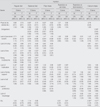Abstract
Purpose
This study was done to investigate the practice level of 14 health behaviors between male (N=139) and female
(N=175) elderly and to identify the barriers to each health behavior of elderly people in Korea.
Methods
Data were collected from 314 elderly people (65 yr and older) living in metropolitan, urban, and rural areas. Descriptive statistics, χ2-test and ordinal logistic regression were used in data analysis using the SPSS Win 15 version.
Results
1) The performances were different in some health behaviors between male and female elderly people. Male elderly showed better performances in balanced diet, regular exercise, and more than 30 min of exercise, while female elderly showed better performances in restriction of fat and cholesterol, restriction on alcohol, and smoking. There were no differences in stress management and health prevention behaviors between the two groups. 2) The common significant barriers in health behaviors of the elderly in Korea were the lack of habit and physical discomfort. However, the lack of perceived benefit was a significant barrier in male elderly. Lack of time and lack of family support were significant barriers in female elderly people in Korea.
Figures and Tables
References
1. Bardenheier BH, Wortley PM, Winston CA, Washington ML, Lindley MC, Sapsis K. Do patterns of knowledge and attitudes exist among unvaccinated seniors? American Journal of Health Behavior. 2006. 30:675–683.
2. Eun Y, Gu MO, Kim ES, Kang YS. A comparative study of health state and need of health-related service between elderly attending senior welfare center and elderly attending a senior citizens' club. Journal of Korean Gerontological Nursing Society. 2001. 3:7–21.
3. Eun YO, Gu MO. A study of the relationships among health promoting behaviors, health locus of control (HLOC), and response patterns to HLOC in Korean elderly. Journal of Korean Academy of Nursing. 1999. 29:625–638.
4. Eun Y, Kim JH, Kim JI, Kim HJ, Kim HS, Oh JJ, et al. A comparative study on barrier factors in health behaviors of urban vs rural elderly. Journal of Korean Academy of Adult Nursing. 2004. 16:531–544.
5. Gu MO. A review of research on health promoting behaviors of Korean older adults. Perspectives in Nursing Science. 2006. 3:17–34.
6. Gu MO, Eun Y. Health promoting bahaviors of older adults compared to young and middle aged adults in Korea. Journal of Gerontological Nursing. 2002. 28(5):46–53.
7. Gu MO, Kim JH, Kim JI, Kim HJ, Kim HS, Oh JJ, et al. A study on the barriers to health behavior in elderly people in Korea. Journal of Korean Gerontological Nursing Society. 2003. 5:117–126.
8. Heidrich SM. Health promotion in old age. Annual Review of Nursing Research. 1998. 16:173–195.
9. Kim CG. Factors influencing health promoting behaviors of the elderly. Journal of Korean Academy of Community Health Nursing. 2002. 321–331.
10. Kim CG, Sung MS. Factors influencing health promotion behaviors with elderly: health concepts and family supporting. Journal of Korean Academy of Fundamentals of Nursing. 2002. 9:133–143.
11. Kim SH. The association between expectations regarding aging and health promoting behaviors among Korean older adults. Journal of Korean Academy of Nursing. 2007. 37:932–940.
12. Kim JS. Middle and long term development planning of elderly health and welfare for the 21st century of the very old society. 1999. Seoul: The Ministry of Health and Welfare.
13. Statistical report. 2006. Korea National Statistical Office;
http:// www.nso.go.kr.
14. Kwong EW, Kwan AY. Participation in health-promoting behavior: Influences on community-dwelling older Chinese people. Journal of Advanced Nursing. 2007. 57:522–534.
15. Lee TW, Ko LS, Lee KJ. Health promotion behaviors and quality of life among community dwelling elderly in Korea: A cross sectional survey. International Journal of Nursing Studies. 2006. 43:293–300.
16. Statistical report. 2006. National Health Insurance Corporation;
http://www.nhic.or.kr.
17. Park SO, Baek HJ, Kim CM, Moon JH, Choi SY, Kim JS, et al. The relationship among health promoting lifestyle, self esteem and social support of elderly people. Journal of Korean Academy of Community Health Nursing. 2003. 14:144–156.
18. Park YJ, Lee SJ, Park ES, Chang SO. A prediction model for health promoting behavior of the Korean elderly. Journal of Korean Academy of Nursing. 1999. 29:281–292.
19. Pastorino CA, Dicky T. Health promotion for the elderly, issues and programming planning. Orthopedic Nursing. 1990. 9(6):36–42.
20. Pender NJ, Murdaugh C, Parsons MA. . Health Promotion in Nursing Practice. 2006. 5th ed. Upper Saddle River, NJ: Pearson/Prentice-Hall;39.
21. Shin SR. Analysis of smoking and smoking cessation related nursing research in Korea and its future direction. Journal of Korean Academy of Nursing. 2006. 36:415–425.
22. Song YS, Lee MR, Ahn EK. The study on health promoting lifestyle of the elderly. Journal of Korean Academy of Nursing. 1997. 27:541–549.
23. Unden AL, Elofssons S. Do different factors explain selfrated health in men and women? Gender Medicine. 2006. 3:295–308.
24. United States Special Committee on Aging. Health status and Health services utilization. In Aging America: Trends and Projections. 1987. Washington, D.C: U.S. Department of Health and Human Services.




 PDF
PDF ePub
ePub Citation
Citation Print
Print






 XML Download
XML Download